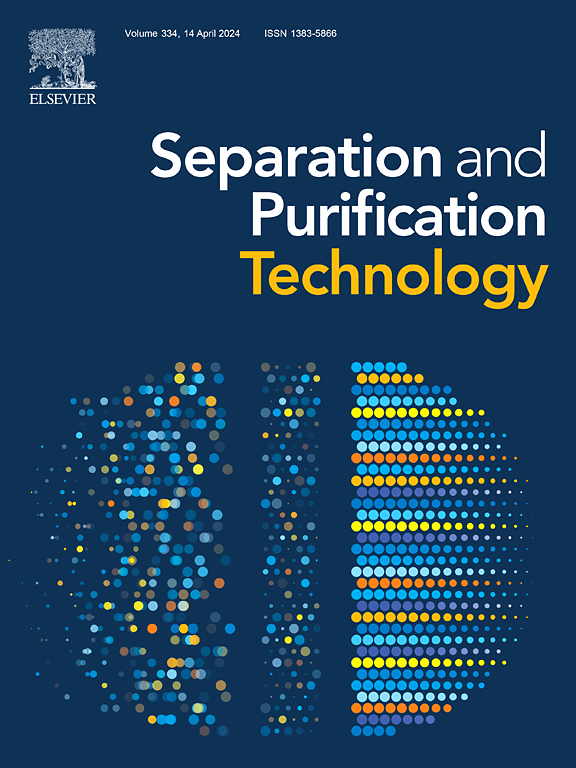Cobalt ferrite-MXene Nanohybrid: A dual-action approach for synergistic doxorubicin removal through adsorption-photocatalysis
IF 8.1
1区 工程技术
Q1 ENGINEERING, CHEMICAL
引用次数: 0
Abstract
The increasing presence of emerging organic contaminants (EOCs), including pharmaceuticals, constitutes a serious threat to aquatic biological systems and human beings primarily due to the persistence and bioaccumulative nature of EOCs. Among these, doxorubicin (DOX), a widely used chemotherapeutic agent, has emerged as a significant environmental contaminant due to improper disposal. This study presents a dual-function nanohybrid comprising of cobalt ferrite-MXene () synthesized via a wet sonication method as a very effective material for the removal of DOX through synergistic adsorption and photocatalysis. The structural and surface properties of the samples were comprehensively characterized using X-ray Diffraction (XRD), Transmission Electron Microscopy (TEM), Scanning Electron Microscopy (SEM), Fourier Transform Infrared Spectroscopy (FTIR), UV–Visible (UV–Vis) spectroscopy, X-ray Photoelectron Spectroscopy (XPS), and Dynamic Light Scattering (DLS), which confirmed successful fabrication of nanohybrid. Vibrating Sample Magnetometer (VSM) was also utilized to investigate the magnetic properties of nanohybrid. Under optimized circumstance, nanohybrid demonstrates remarkable adsorption capacity (15.16 mg/g) and photocatalytic efficiency, leading to a 97 % DOX removal at pH 8.5. The adsorption process is based on pseudo-second-order kinetics as well as Sips isotherms, highlighting multilayer adsorption on heterogeneous active sites. Enhanced photocatalytic degradation is attributed to the formation of a Schottky junction which promotes efficient electron-hole separation. The recyclability of the material is proven up to five cycles with negligible loss in performance which indicates stability and reusability. These findings suggest that the developed nanohybrid offers a cost-effective, recyclable and eco-friendly approach for removing DOX from wastewater. Its enhanced performance without generating secondary toxic substances, making it a sustainable approach for environmental remediation.


铁酸钴- mxene纳米杂化物:吸附-光催化协同去除阿霉素的双作用方法
包括药物在内的新兴有机污染物(EOCs)的存在日益增加,主要由于其持久性和生物蓄积性,对水生生物系统和人类构成了严重威胁。其中,多柔比星(DOX)是一种广泛使用的化疗药物,由于处置不当,已成为一种重要的环境污染物。本研究提出了一种由铁酸钴- mxene组成的双功能纳米杂化物(CFO-Ti3C2CFO-Ti3C2),通过湿法超声合成,作为一种非常有效的材料,通过协同吸附和光催化去除DOX。利用x射线衍射(XRD)、透射电子显微镜(TEM)、扫描电子显微镜(SEM)、傅里叶变换红外光谱(FTIR)、紫外可见光谱(UV-Vis)、x射线光电子能谱(XPS)和动态光散射(DLS)对样品的结构和表面性能进行了全面表征,证实了CFO-Ti3C2CFO-Ti3C2纳米杂化物的制备成功。利用振动样品磁强计(VSM)研究了纳米杂化材料的磁性能。在优化条件下,CFO-Ti3C2CFO-Ti3C2纳米杂化物的吸附量为15.16 mg/g,光催化效率高,在pH为8.5时对DOX的去除率为97% %。吸附过程基于准二级动力学和Sips等温线,突出了多相活性位点上的多层吸附。增强光催化降解归因于肖特基结的形成,该结促进了有效的电子-空穴分离。材料的可回收性被证明长达五个循环,性能损失可以忽略不计,这表明稳定性和可重用性。这些发现表明,所开发的纳米混合材料为去除废水中的DOX提供了一种经济、可回收和环保的方法。它的性能增强,不产生二次有毒物质,使其成为环境修复的可持续方法。
本文章由计算机程序翻译,如有差异,请以英文原文为准。
求助全文
约1分钟内获得全文
求助全文
来源期刊

Separation and Purification Technology
工程技术-工程:化工
CiteScore
14.00
自引率
12.80%
发文量
2347
审稿时长
43 days
期刊介绍:
Separation and Purification Technology is a premier journal committed to sharing innovative methods for separation and purification in chemical and environmental engineering, encompassing both homogeneous solutions and heterogeneous mixtures. Our scope includes the separation and/or purification of liquids, vapors, and gases, as well as carbon capture and separation techniques. However, it's important to note that methods solely intended for analytical purposes are not within the scope of the journal. Additionally, disciplines such as soil science, polymer science, and metallurgy fall outside the purview of Separation and Purification Technology. Join us in advancing the field of separation and purification methods for sustainable solutions in chemical and environmental engineering.
 求助内容:
求助内容: 应助结果提醒方式:
应助结果提醒方式:


